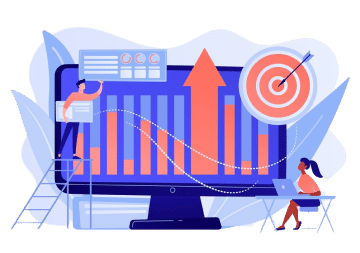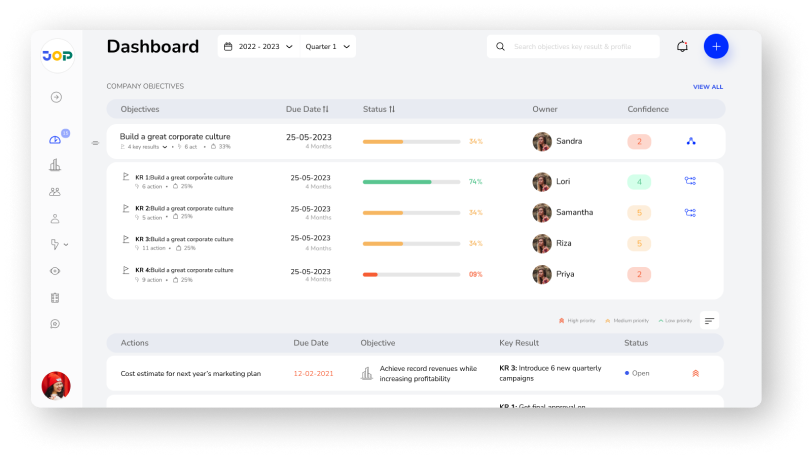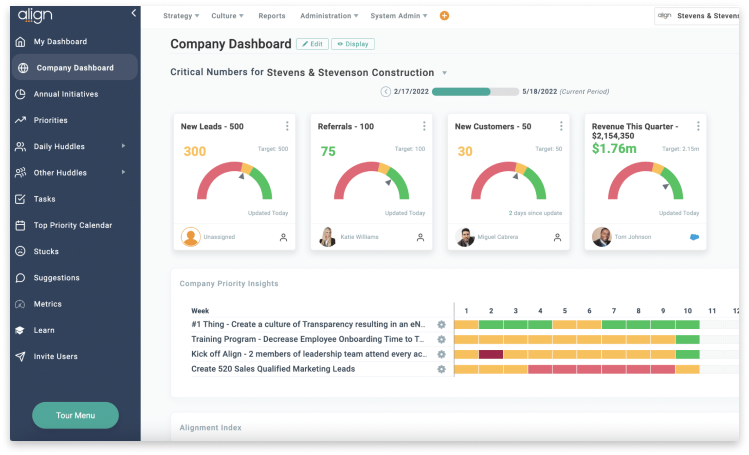7 Best OKR Software for Startups to Achieve Goals in 2025

On this page
OKR is an acronym for Objectives and Key Results. It was gaining popularity as an essential startup goal-setting system not long ago. While famous for creating transparency and measurable accomplishments that guide teams working toward higher corporate objectives, many startups would like to use OKR software for startups to make better use of this process.
Here’s a view of some of the best options for OKR software explicitly designed for startups, along with features and benefits.
1. JOP (Joy of Performing)

JOP (Joy of Performing) is a holistic OKR software platform tailored for small businesses, effectively streamlining goal-setting while offering a comprehensive set of features to enhance team alignment and overall performance. It enables startups to set clear objectives and measurable key results, fostering a strong connection between individual roles and the company’s broader goals.
Key features of JOP:
- Goal Setting
- Real-Time Monitoring
- Custom Dashboards
- Team Alignment
- Check-Ins
- Advanced Reporting
- Streamlines goal-setting processes
- Facilitates team alignment with company strategy
- User-friendly interface for quick adoption
Love from our customers




JOP’s team knew solving such challenges required a level of alignment and momentum that had not been seen by the team before, and that OKRs were the best solution ! Paislei finally decided to place their trust in us for 2 quarters, and the rest, as they say, is history!
Mayank Sabharwal
Founder and Managing Director - Paislei2. Lattice

Lattice is an all-in-one performance management solution that integrates OKR functionality, making it appealing for startups that want to combine goal setting with employee engagement and performance reviews. It helps teams foster a culture of continuous improvement through aligned objectives.
Key features:
- Performance Reviews
- Employee Engagement Surveys
- Learning Management
- Comprehensive performance management tools
- Comprehensive performance management tools
- May be overwhelming for very small teams
- Higher pricing tier for premium features
3. Weekdone

Weekdone is a straightforward OKR platform designed for startups that thrive on regular feedback and communication. It fosters accountability and transparency through weekly check-ins, making it an effective tool for tracking progress and maintaining momentum.
Key features:
- Regular Check-Ins
- Visible On-the-Job Progress
- Intuitive Interface
- Easy to use and implement
- Promotes regular feedback loops
- Limited features for in-depth performance analysis
- May require additional tools for comprehensive reporting
4. BetterWorks

BetterWorks is a cloud-based OKR software designed for scalable startups. It emphasizes goal alignment and real-time insights, making it an excellent choice for organizations focused on enhancing performance through strategic objectives.
Key features:
- Goal Cascades
- Real-Time Dashboards
- AI-Driven Insights
- Enables effective goal alignment across teams
- Provides actionable insights for performance improvement
- Can be complex for smaller startups
- Higher costs may not suit all budgets
5. Align

Align is a mobile-first OKR platform that excels in flexibility, making it perfect for remote and dispersed teams. Its user-friendly mobile application ensures employees stay aligned with their objectives, encouraging collaboration and effective communication regardless of location.
Key features:
- Mobile Accessibility
- Alignment of Teamwork
- Live Updates
- Convenient access through mobile devices
- Encourages collaboration among remote teams
- Limited features for desktop users
- May lack advanced reporting capabilities
6. Ally
Ally connects individual goals with organizational objectives, empowering every employee to contribute to the company’s mission. This alignment fosters a strong culture of teamwork and motivation, making it an essential tool for startups focused on employee engagement.
- It’s a bit customizable as per organization’s need
- It has plenty of product-based resources
- It gets frequent fixes and updates
- UI is unclear and less intuitive
- Report exporting feature is not available
- Starts from $8 per user per month
7. Motivosity
The team at Motivosity has a mission to make the workplace happier with their dedicated employee recognition and feedback tools.
360-degree performance reviews provide comprehensive insights into employee performance while ensuring a well-rounded view of individual contributions. Provide ongoing guidance and support to employees using continuous feedback to help them reach their full potential.
Strengthen employee-manager relationships by holding regular 1:1 meetings and documenting valuable takeaways for future growth. Having a section dedicated to these regular meetings aids in employee development.
Allow for public recognition, comments, and feedback in order to foster a positive and supportive work environment. The customized rewards system from Motivosity enables you to recognize employees in meaningful ways, making them feel valued and appreciated.
Regular 1:1 meetings encourage open and candid conversations between employees and managers, strengthening relationships and driving growth.
Motivosity enables you to collect valuable feedback and insights from employees via surveys, allowing you to gain a better understanding of employee satisfaction and engagement.
One Motivosity feature enables you to gain powerful insights into each manager’s performance, allowing C-suite leaders to drive organizational success through targeted feedback.
- You can publicly recognize others with specific reasons
- It has a quick shout-out feature for peer-peer recognition
- You can give customized gifts to recognize team members
- It lacks major integrations like Slack
- The company feed gets overwhelming with a lot of updates
- $8 per user per month for full platform features
8. Engagedly
Built with a mission to make the workplace fun and inspiring, Engagedly offers an employee engagement and performance management platform. It has all the useful tools to enhance the overall employee experience.
Set and manage goals with ease, aligning individual objectives with the vision of the organization. Streamline performance evaluations to make the process more efficient and effective.
Create a feedback-rich environment by providing continuous and 360-degree feedback, ensuring a comprehensive view of employee progress.
Custom rewards can be used to recognize and reward employees for their efforts, fostering motivation and loyalty.
The employee analytics feature of Engagedly provides valuable data-driven insights, allowing you to make informed decisions to improve employee performance and engagement.
Employee surveys provide deeper insights into employee experiences, allowing you to address concerns and create a thriving work culture.
Empower your workforce with valuable resources for continuous learning and skill enhancement with Engagedly’s internal training programs on the LMS and mentoring tool.
- The ability to assign, complete and track courses for employees in their LMS
- It makes new employee onboarding easier in the company
- It can store useful and handy information like HR policies
- The multi-rating feature should be more optimized
- It’s mobile app should be more useful and feature-rich
- Agreement starts at $5000 annually
9. PerformYard
This platform is a complete toolkit focused on performance management.
Continuous performance reviews help you manage and align goals throughout your organization, driving clarity and focus in every role. Encourage open communication and employee growth by embracing a feedback-rich culture with continuous feedback.
Furthermore, their 360-degree performance reviews provide a comprehensive view of employee contributions from multiple perspectives, ensuring a well-rounded evaluation.
The employee data dashboard from PerformYard provides individual information and valuable insights into individual performance, enabling managers to make data-driven decisions.
- The platform has a good level of customization
- It has one place to manage the feedback of individuals
- You can integrate HRIS (Human Resources Information System)
- The number of features could be limiting for many organizations
- Mobile app should be more consistent with the desktop version
- Up to $10 per user per month for the Performance Management
10. Namely
HR and Performance Management platform for Mid-sized companies (25-1000 employees).
Manage and align goals throughout your organization with ease, fostering clarity and unity. Conduct effective performance reviews to assess employee progress and provide useful feedback for future development.
Encourage a feedback-rich culture by providing continuous and 360-degree feedback to all employees, ensuring that their voices are heard and valued. Recognize employee contributions with recognition tools to foster an appreciation and motivational culture.
Keep your workforce engaged and up to date by staying informed and connected with the latest company updates via Namely’s company news feed.
Automate task lists for more efficient performance management software, allowing you to devote more time to strategic initiatives.
- It has a responsive and intuitive mobile and desktop application
- It has individual employee data in one place
- HRIS processes are smooth, especially the payroll processing
- Complex UI due to unnecessary features
- HR Payroll tools are not well optimized for a good UX
- Not available on its website
Choosing the best performance management
software
The best performance management software for your company should have fundamental and customized features suitable for your company.
As discussed above, your teams should practice Continuous Performance Management to continuously optimize their work for higher performance.
You should consider organizational factors like your work culture, key business goals, company size, budget, IT infrastructure, and team members’ opinions and concerns.
When you buy new software, test it with a few team members or two teams only.
Whatever tool you buy, don’t ever lose the intent or goal of using the performance management software, i.e., to help your team members perform better.
Frequently Asked Questions
Increased clarity and alignment: It can help to clarify employee goals and expectations and ensure that everyone is on the same page with the overall goals of the company. This can result in a more concentrated and productive workforce.
Continuous feedback: Regular feedback can assist employees in identifying their strengths and weaknesses as well as setting goals for improvement.
Development opportunities: It identifies employee development opportunities. This can help employees grow and develop their skills, leading to better performance.
Increased employee engagement: It aids in increasing employee engagement. Employees are more likely to be engaged in their work when they believe their performance is being tracked and evaluated fairly and transparently.
Improved decision-making: It assists managers in making better decisions by providing insights into employee performance. This data can be used to improve hiring, promotion, and compensation decisions.
Reduce administrative burden: It can automate many performance management tasks, such as goal setting, tracking progress, and providing feedback. This can free up time for managers to focus on other priorities.
Improve compliance: It can assist in ensuring that the company complies with all applicable employment laws. This can help the company avoid legal liability.
The best performance management software for your organization will be based on your specific needs and objectives. Here are a few things to think about before making your decision:
Size of your company: If you have a small team, you may not require all of the features of large-scale performance management software. However, if you have a large team or a complex organization, you will require software that can meet your requirements.
Your industry: Some performance management software is tailored to particular industries, such as healthcare or technology. If your industry has specific requirements, you must select software that can meet them.
Your budget: The annual cost of performance management software can range from a few hundred dollars to several thousand dollars. Before you begin shopping for software, you should decide how much you are willing to spend.
Your desired features:
- Goal setting and tracking
- 360-degree feedback
- Performance reviews
- Coaching and development
- Reporting and analytics
Consider other factors also such as your work culture, ease of use and ongoing support.
When selecting performance management software, this is an important question to ask.
Goal management features in good software will allow employees to set individual objectives that are aligned with the company’s
strategic vision.
This is necessary to ensure that everyone in the organization is working toward the same objectives.
These software offer the above features:
- JOP
- Lattice
- Culture Amp
- 15 Five
Yes, many performance management software solutions seamlessly integrate with existing tools and systems, such as Slack or Google Workspace.
This can be a great way to streamline your workflow and make performance tracking easier:
They can save you time: You can avoid manually entering data by integrating your performance management software with other tools. This can save you a significant amount of time, particularly if you have a large team.
They can improve communication: Integrations can make it easier to communicate about performance with your team. You can use Slack, for example, to send notifications about upcoming performance reviews or to share feedback.
They can improve visibility: Integrations can make it easier to see how different departments or teams are performing. This can assist you in identifying areas where performance is lacking and taking corrective action.
Software providing integrations with major tools like Slack and Google Workspace:
- JOP
- Lattice
- Culture Amp
- 15Five
- Leapsome
Yes, performance management software is capable of tracking employee progress, identifying areas for improvement, and providing feedback.
Here is how software can support employee development and training initiatives:
- Goal setting: Performance management software can assist employees in setting goals that are in line with their developmental requirements.
- Employee feedback: Performance management software can provide employees with feedback on their performance, allowing them to identify areas for improvement.
- 360-degree feedback: It can be collected from employees’ peers, managers, and customers using performance management software. This can assist employees in identifying their strengths and weaknesses and developing an improvement plan.
- Training: Performance management software can track employee progress in training programs and provide performance feedback.
- Reporting: Employee development and training progress can be tracked using performance management software. These reports can be used to identify training needs and evaluate the effectiveness of training programs.
Software that support employee development:
- JOP
- Culture Amp
- Engagedly
Here are some things to look for in the customer support and consultation services of a performance management software provider:
- Consultation on software and performance management framework implementation: The provider should provide consultation services to assist you in implementing the software and developing a performance management framework that is aligned with the goals of your company.
- Employee onboarding and training: The provider should provide onboarding and training services to assist your employees in learning how to use the software and comprehending the performance management framework.
- Ongoing customer support: The provider should provide ongoing customer support to assist you in troubleshooting any issues you may encounter and to answer any questions you may have.
Software companies offering these services:
- JOP
- Lattice
- Culture Amp
Here are some of the data security and compliance practices to look for in a performance management software provider:
- Encryption: To protect data in transit and at rest, the software should use strong encryption.
- Access controls: To limit who can access data, the software should have strong access controls.
- Data backup: To protect data in the event of a breach, the software should include a dependable data backup system.
- Privacy policy: The software provider should have a detailed privacy policy outlining how data is collected, used, and shared.
- Compliance with privacy regulations: The software provider must comply with all applicable privacy regulations.
Almost all the software listed above are secure.
These methods can help you determine the ROI of your performance management software:
- Set clear goals: Prior to implementing the software, establish clear goals for what you want to achieve. This will allow you to calculate the ROI more precisely.
- Track the right metrics: Monitor the appropriate metrics: Not all metrics are created equal. Select the metrics that are most important to your organization and will provide you with the most accurate picture of ROI.
- Use a control group: If possible, use a control group to compare the software’s results to the results of a non-software group. This will allow you to isolate the effects of the software and calculate the ROI more precisely.
- Employee turnover: Keep track of how many employees leave the company each month or year.
- Customer satisfaction: Keep track of the number of customer complaints, referrals, and the customer satisfaction score.
Related Posts
View All
 Nishant Ahlawat
Nishant Ahlawat